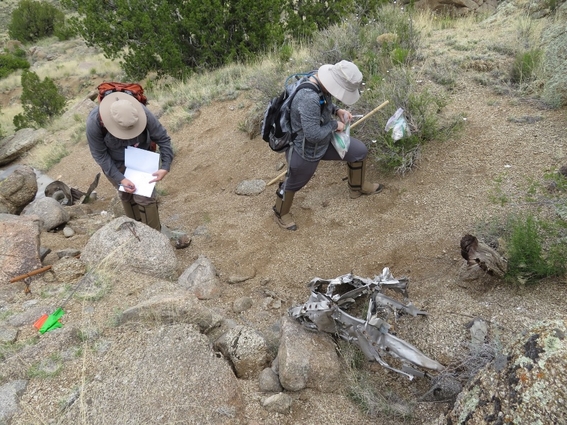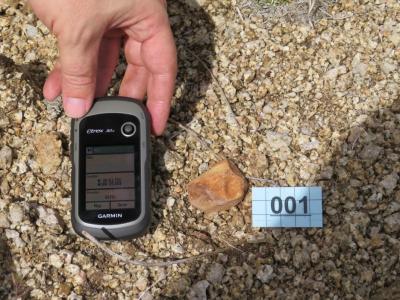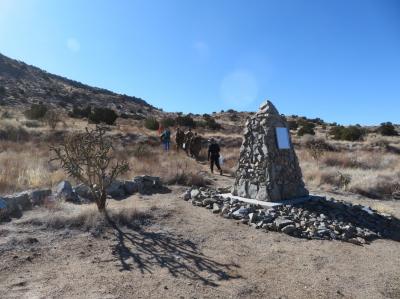LLNL researchers salvage broken arrow samples
 (Download Image)
(Download Image)
LLNL researchers Matt Lyman and Salustra Urbin collect and catalog samples taken from a B-29 crash site in 1950 in New Mexico.
It was a cool spring day in May 2019. LLNL researchers Mark Hart, Matt Lyman and Salustra Urbin were combing through rusted propellers and a split Mk4 bomb case in the foothills of Manzano Mountain, just a few miles east of Kirtland Air Force Base in New Mexico. The LLNL team was exploring three different plane crashes that had occurred on the mountain, but it was the remnants from a “broken arrow” – an accident involving nuclear weapons – that caught their attention.
One of four Comp B specimens collected, marked by GPS coordinates.The broken arrow took place April 11, 1950, when a B-29 carrying a Mk4 atomic bomb crashed into the mountain shortly after takeoff. It was the second broken arrow and the first in the continental U.S. While there were no survivors, responders arrived within minutes and were able to retrieve all sensitive components and materials. Much of the high explosives (HE) burned in the gasoline fire, but some HE was scattered in the crash on the mountainside.
Hart coordinated access to the site with Kirtland Air Force Base installation commander Col. Richard Gibbs, and engaged participation by James Green, Kirtland Air Force Base’s Manzano Complex facility manager, as well as Matt Thompson and Tim Frederick, the DTRA-Defense Nuclear Weapons School team. All six individuals hiked up the steep mountainside to explore the wreckage. To their surprise, they found several small fragments of HE from the Mk4 that were visible among the wreckage of the historic crash site.
Kirtland Air Force Base 377th Air Base Wing Explosive Ordnance Disposal and Civil Engineering group hiking up Manzano Mountain past B-29 Crash Monument to retrieve Comp B specimens.
“I couldn’t believe that HE was sitting there on that mountain for 70 years,” Hart said. “Others apparently knew there were some remnants, but nobody picked up on the fact that it might be anything significant.”
Of particular interest to the LLNL team are the imprints of time and the environmental extremes that these samples have endured since 1950. Samples of various materials are sometimes heated in Laboratory ovens to mimic the natural aging process. These naturally aged samples could provide a way to validate their assumptions about how the aging process changes material properties – chemical, physical, mechanical and dimensional.
A key aspect of the Laboratory’s stockpile stewardship mission is assessing the safety and performance of the aging nuclear weapon stockpile. HE is an important part of every nuclear weapon in the stockpile, and as an organic material, it deteriorates over time. Understanding how HE ages, and how degradation might impact safety and performance is of critical importance to national security.
After months of coordination and approvals, Hart returned in January 2020 to collect the 70-year-old HE samples. The collection was performed by Kirtland Air Force Base 377th Air Base Wing Explosive Ordnance Disposal and the Civil Engineering group. The specimens were cataloged and shipped back to LLNL.
Comp B specimen found in situ.The HE samples are a different formulation than the modern insensitive HE that is in much of the current stockpile. However, the aged samples may provide a unique opportunity to enhance the validation of the computer models used to predict how aging affects these various types of HE. These models play an important role in the annual assessment of the current stockpile, which culminates in an annual letter to Congress and the president quantifying the level of certainty in the safety, security and effectiveness of the nuclear stockpile. These models also will play an important role in the W80-4 Life Extension Program (LEP), one of two stockpile modernization programs led by LLNL. As part of the W80-4 LEP, LLNL will be replacing the warhead’s aged HE.
Hart and Lyman, under the direction of LLNL program manager Kristl Adams, are working with colleagues at the Laboratory to plan how they will characterize and test the samples to get data useful for the Laboratory’s national security missions.
Contact
Nolan O'Brien[email protected]
925-422-3399
Related Links
Physical and Life Sciences at LLNLTags
Bioscience and BioengineeringBiosecurity and Bioforensics Group
Physical and Life Sciences
Featured Articles










